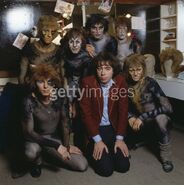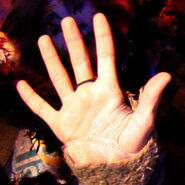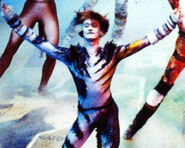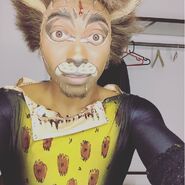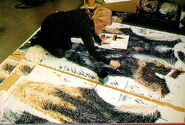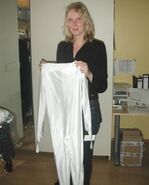The costumes in Cats are defined by the unique painted "Catsuit" - the spandex second skin suit most commonly referred to as a unitard, but also known as a leotard or skinsuit. Cats unitards must fill the demands of the show - the costumes must look as sleek and seamless as possible, they must be hard-wearing and washable, comfortable and allow the dancers a full range of movement.
History[]
Cats premiered in 1981, and was a catalyst in the 1980s Lycra Revolution. Early cast photos show a rapid development in techniques used in Cats costumes, from the Original London Cast wearing commercial patterned suits with experimental paints, to early productions trying to solve the problems presented by the dance-heavy show.
One of the biggest problems is in dressing - getting the costumes on and off. A back seam zipper is common in commercial unitards, however this has distinct disadvantages in a dance-heavy show - the back zip doesn't stretch and move with the performer, and when a zip fails it takes time and patience to repair and would leave the performer unable to go onstage until it is fixed. The solution was to use the shoulder seams as the opening, using either poppers or hooks and eyes to fasten the neckline. These fastenings are then generally disguised by the shoulder "Fluffies", however on characters like Cassandra the fastenings are often more apparent.
Construction[]
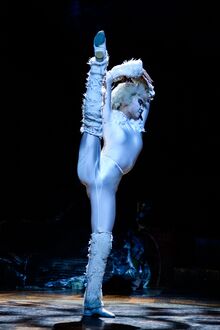
Victoria's pose shows seam lines
Authentic Cats unitards are closely tailored to the actor's proportions. The unitard body is cut from a single piece of fabric, with seams at the centre back and inside leg. The unitards are built with full feet.
The pattern includes a triangular crotch gusset, which takes the strain of draping a two-dimensional fabric over a three-dimensional body. The gusset means the centre back seam is not pulling directly on the front of the costume, so reduces the chances of the inner leg seam splitting under tension. Generally staring at a performer's crotch is rather indiscreet, however Victoria's Solo illustrates the crotch gusset fitting clearly.
Often the stage-worn costumes also include darts for a closer fitting, generally on the sides of the ribs to waist and at the neck. The side darts are drawn towards to centre back rather than being truly on the side seam line, this helps hide them. The neck dart often gives the appearance of a "collar" pattern piece, however it is a dart set in the final fitting.
Sleeves[]
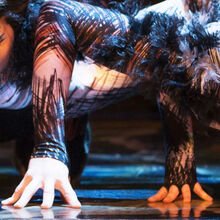
Coricopat (left), Tantomile (right), contrasting sleeve styles
The sleeves end in some variety of hand/thumb loop - the exact construction varies between production and sometimes by maker within the same production. The Broadway style construction involves a complex full hand, with slits for the fingers, and a hole in the palm to allow the actor to pull their hand through. The London style encases the thumb in fabric, allowing the hand to remain uncovered while keeping the tension on the sleeves.
The full-hand design is mostly used for female characters, while equivalent male characters have the simplest stirrup design, as seen in this photo of Coricopat and Tantomile from Australia 2015, where their otherwise identical twin costumes have the sleeves finished differently.
Grizabella demonstrates an important element of all the designs - the ability for the performer to slip their hand out of the costume, while doing tasks such as makeup, washing their hands etc.
Less common than the thumb loop or stirrup style, is the longer sleeve/covered palm style as seen on Pouncival from Paris 1989. Having the palm covered gives a level of protection to the actor's hand, however this also reduces friction and will wear through at a significantly higher speed than the styles that leave the palm uncovered. Aesthetically this style has almost as much coverage as the open palm style seen primarily on female characters, so extends the costume and reduces the immediate recognition of human proportions. The audience sees the palm as part of the "paw", and the fingers can be seen as "claws".
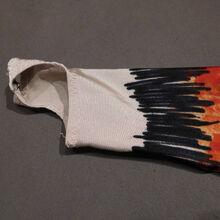
Mungojerrie costume, London 2000
This Mungojerrie costume is from London, 2000, and shows the relatively simple construction of the UK-style thumb loop. The stretch of the spandex means that the stirrup section between the thumb and the hand will sit comfortably, while the thumb is covered by fabric.
Mistoffelees' song costume jacket also uses thumb loops to secure the sleeves in place. To create a subtle, smooth appearance, in 2013 the thumb loops were made in a close match to the performer's skintone. However no such effort was made just two years later, where the black fabric contrasts the performer's pale skin. The Broadway Revival version gives Misto a longer sleeve, which covers more of his hand and creates more of a "paw" illusion.
Necklines[]
Necklines vary with the character and production, it is clear on the original designs that John Napier intended a variety of necklines from fully covering to lower and open on the shoulders, requiring the actor to continue their makeup down their neck.
Both hook and eyes, and snaps/poppers, are common on Cats costumes, often both are seen within one production. Snaps are somewhat easier to use, but hooks and eyes are easier to repair and replace.
Construction Process[]
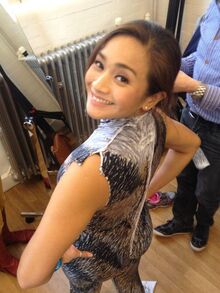
Joanna Ampil in costume fitting ,UK Tour 2013
The Costume construction process starts with the actor's measurements which are turned into a pattern, from which a "toile" unitard is made and fitted on them. Once the fit is confirmed, the pattern is drawn up onto fabric, which is dyed. This is then sewn up and fitted onto the actor, where the details such as darts are set, then the costume is finished off. The tail, legwarmers, etc, are held in place with poppers which are set in the final fitting.
Dyeing and Painting are two different techniques, defined by the effect on the fabric at a microscopic level. Paints sit on top of the fabric fibres, whereas dyes chemically penetrate the fibres to change their colour. Paints wear off with friction, while dyes will not, however dyes can run with repeated washing. Although the costumes are referred to as being "painted", the actual chemical process is dyeing.
Cats unitards are dyed with acid dyes. The fabric used is generally a high quality nylon/spandex blend, which is a hard-wearing fabric common in dancewear and swimwear. However nylon is difficult to dye, and requires specific acid dyes. Commonly acid dyes are used in a dye bath, submerging the entire fabric in the dye and using heat to activate the chemical reaction. However in order to paint the patterns on Cats costumes, the dyes are treated with a thickener to allow them to be painted on. The dyes are then activated in a steamer, a technique generally used for silk painting. The difficulty comes from the single seam unitard pattern, which results in a single sheet of fabric some 5' square.
It appears the Dusseldorf production experimented with using airbrush techniques on finished unpainted unitards, which resulted in very smooth gradients, but sparse and under-decorated results.

